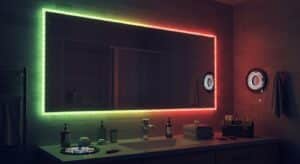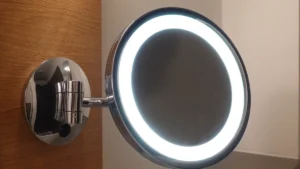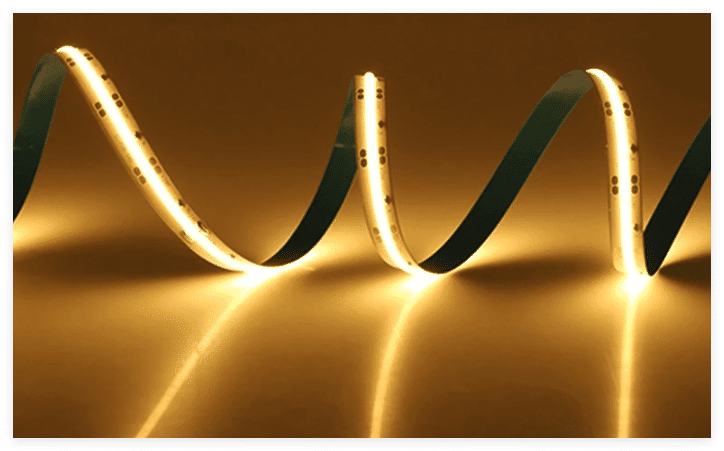
When selecting the best COB LED strip lights, it’s crucial to understand the differences. COB lights provide smooth, dot-free lighting, making them ideal for areas that require high-quality illumination. SMD strip lights are highly flexible and can be customised for various applications. The best COB LED strip lights are energy-efficient and have a longer lifespan, whereas SMD strips are more affordable and available in a wider range of colours and brightness options. Whether you are seeking the top COB lights for exceptional lighting or versatile SMD strips, comprehending these distinctions will aid you in making an informed choice.
Key Takeaways
COB LED strips give smooth light without dots. They are great for brightening areas you can see clearly.
SMD LED strips cost less and bend easily. They come in many colours and brightness levels for different uses.
Think about energy use: COB strips stay cooler, but SMD strips make more light with less power, saving electricity.
Pick COB strips for strong, lasting light in tough places. Choose SMD strips if you want cheaper and flexible options.
Match your project needs: COB strips are best for even light. SMD strips work well for fun and changeable designs.
Understanding COB and SMD LED Strip Lights
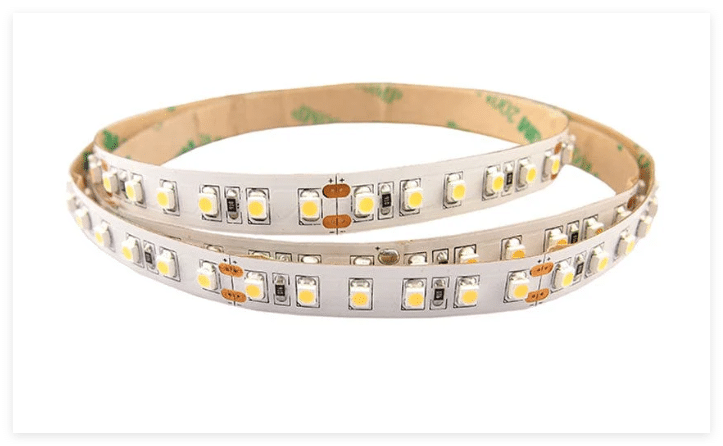
What Are COB LED Strips?
COB LED strips, meaning “Chip on Board,” are a modern lighting option. These strips use many tiny LED chips placed on a flexible board. A glue layer with fluorescent powder covers the chips. This improves light quality and spreads it evenly. The design removes the “dot effect” seen in older LED strips. It creates smooth, continuous light.
A key feature of COB LED strips is better heat control. The tightly packed chips stay stable and avoid overheating. These strips also shine light at a wide angle, up to 180 degrees. This makes them great for even lighting, like under cabinets or for decorative accents.
Here’s a simple comparison of COB LED strips and SMD LED strips:
Feature | COB LED Strip Lights | SMD LED Strip Lights |
|---|---|---|
Design | Many small chips on one board | Individual LED bulbs on a circuit board |
Light Angle | Wide, up to 180 degrees | Narrower, about 120 degrees |
Lumens per Watt | 90 Lumens per watt | 85 Lumens per watt |
Price | £33.60 for 5m, 24V Single Colour | £30.00 for 5m, 24V SMD LED Strip Light |
Lifespan | Around 30,000 hours | Around 30,000 hours |
Warranty | 3 years | 3 years |
Heat Dissipation | Better heat control | Standard heat control |
Market History | Became popular in late 2000s | Used since the 1960s |
What Are SMD LED Strips?
SMD LED strips, or “Surface-Mounted Device” strips, are very common today. These strips have single LED bulbs placed on a flexible board. Unlike COB strips, SMD strips allow more colour and brightness choices. You can get them in single-colour, RGB, or adjustable white options.
SMD LED strips are very flexible. They come in different models with special features. For example:
Some models, like the RQW078C, are very bright (170 lumens per watt) and offer warm to cool white tones.
Others, like the RQT074C, let you adjust colours and work indoors or outdoors due to waterproofing.
These strips are great for decoration, signs, or projects needing flexibility. They may not give smooth light like COB strips. But they are cheaper and easy to customise, making them a favourite choice.
Comparing COB and SMD LED Strips
Light Quality and Distribution
COB LED strips give smooth and even light. The chips are close together, so there are no dots or bright spots. This makes them great for clean lighting in high ceilings or fancy designs. Their focused light is sharp and bright, perfect for detailed work.
SMD LED strips spread light over bigger areas. They are good for kitchens, bathrooms, or shops. But they can cause more glare than COB strips. This might not be ideal for places needing softer light.
Main differences in light quality and spread:
COB LEDs give smooth, dot-free light for long-term use.
SMD LEDs offer bright, colourful light for flexible needs.
COB strips need bigger heat sinks, while SMD strips are cooler and brighter.
Energy Efficiency
Energy use is important to think about. COB LED strips handle heat well. Their chips touch the base metal, keeping them cool. This lowers their temperature and saves energy, even if they use a bit more power.
SMD LED strips cool down using air movement. This is less effective, so they get hotter. Still, they make more light per watt, which saves money if brightness matters more than heat.
Energy efficiency points:
COB strips stay cooler with better heat control.
SMD strips use less power but can get hotter.
Both save energy compared to old-style lights.
Flexibility and Design
SMD LED strips are more flexible. They work for many uses, like decorations or practical setups. You can get them in single colours, RGB, or adjustable white. Some are waterproof, so they’re good for outdoors too.
COB LED strips are less flexible but compact. Their smooth light is great for simple, stylish designs. They don’t have as many custom options as SMD strips.
Type of LED Strip | Benefits |
|---|---|
Single Signal Addressable LED Strips | Easy to set up with just one data signal. |
Dual Signal Addressable LED Strips | Reliable with a backup line if one fails. |
Breakpoint Resume Addressable LED Strips | Keeps working even if one LED stops, so the strip stays lit. |
Data + Clock Signal Addressable LED Strips | Offers precise control, useful in tricky signal areas. |
Design flexibility comparison:
COB LEDs are best for simple, smooth lighting styles.
SMD LEDs are more adaptable, with lots of custom options.
Knowing these differences helps you pick the right LED strip. Think about energy, light, and design needs before deciding.
Cost Considerations
When picking between COB and SMD LED strips, price matters a lot. COB LED strips cost more because of their advanced design. They use many small LED chips on one board. This makes them expensive to produce but gives better light and efficiency. They are a smart choice for high-quality lighting needs.
SMD LED strips are cheaper and fit smaller budgets. Their simple design and easy availability make them popular. Prices vary based on brightness, colours, and waterproofing. They don’t give smooth light like COB strips, but they are affordable. This makes them great for decorations and general lighting.
Feature | COB LED Strips | SMD LED Strips |
|---|---|---|
Initial Cost | Higher due to advanced design | Lower, good for budget-friendly projects |
Long-term Value | Great due to energy savings and durability | Decent, but may need replacing sooner |
Customisation Options | Limited, focused on smooth light | Many options, including colours and features |
Tip: Choose COB strips for premium lighting and long-term savings. Pick SMD strips for flexible and budget-friendly solutions.
Durability and Longevity
How long LED strips last is very important. COB LED strips are strong and last longer. Their design keeps chips cool and reduces damage. They stay bright for years, even with heavy use. This makes them perfect for tasks needing steady, reliable light.
SMD LED strips are also durable but don’t last as long as COB strips. Some models, like the LUXEON SunPlus 3030, perform well with different colour options. However, they rely on air to stay cool, which can wear them out faster in hot places. Still, they work well for most home and business uses.
Key points about durability and lifespan:
COB LED Strips:
Built to last with excellent heat control.
Stay bright and stable over time.
Best for tough jobs like task or architectural lighting.
SMD LED Strips:
Strong enough for daily use but wear out faster in heat.
Offer many choices for less demanding uses.
Great for short-term or decorative projects.
Note: For hot areas or constant use, COB strips are more reliable. SMD strips are better for simple, cost-effective setups.
Pros and Cons of COB LED Strips
Advantages of the Best COB LED Strip Lights
COB strip lights have many benefits for different lighting needs. They give smooth, dot-free light, which looks clean and professional. The “chip on board” design spreads light evenly. This makes them great for workspaces or stylish designs needing steady light.
Another benefit is their energy efficiency. COB lights use less power but still shine brightly. This helps save on electricity bills while giving excellent lighting. They also handle heat well, which makes them last longer and saves money over time.
COB LED strips are small and flexible. Their slim shape fits in tight spots, like under cabinets or for decoration. They also shine light widely, covering more space with fewer strips needed.
Tip: Choose COB strip lights for bright, energy-saving, and high-quality lighting.
Disadvantages of COB LED Strips
COB strip lights also have some downsides. One big issue is their higher price. Their advanced design and great light quality make them cost more. This might not work for people with smaller budgets.
Another drawback is fewer customisation options. COB strips don’t offer many colours or adjustable features. They are not the best choice for colourful or changing light setups.
Lastly, installing COB strips can be tricky. They often need special power supplies and heat sinks to work well. This can make setup harder and more expensive.
Note: Think about your budget and lighting needs before picking COB strips. They are perfect for long-lasting, high-quality lighting but not ideal for colourful or low-cost projects.
Pros and Cons of SMD LED Strips
Advantages of SMD LED Strips
SMD LED strips have many benefits, making them widely used. They are flexible and can be used in creative ways. You can use them for accent lighting, signs, or outdoor decorations. These strips come in single-colour, RGB, or adjustable white options. This gives you plenty of choices for different needs.
Newer SMD LED strips use advanced technology for better performance. For example:
3528 LEDs are affordable and work well in large amounts. They are bright when used in high-density setups.
5050 LEDs are brighter than 3528 LEDs, perfect for areas needing strong light.
3020 and 3014 SMD LEDs are smaller and more efficient. They allow more LEDs on a strip, making them brighter.
2835 chips are often used in industrial lights. They are a big improvement in LED technology, offering better performance.
SMD LED strips are also cost-effective. Their low price makes them great for budget projects. They are lightweight and easy to install, even in tight spaces.
Tip: Pick SMD LED strips for affordable, flexible, and simple lighting solutions.
Disadvantages of SMD Strip Lights
SMD LED strips have some downsides to think about before buying. The table below shows their main disadvantages:
Disadvantage | Description |
|---|---|
Point-Like Light Source Issues | SMD strips may show visible dots, which can look distracting. |
Heat Dissipation Issues | Without good cooling, heat can shorten their lifespan. |
Lower Brightness and Colour Rendering | SMD LEDs may not be as bright or colourful as COB LEDs. |
Limited Options for High-Density Applications | SMD strips may not work well for tasks needing very bright, even light. |
These issues mean SMD LED strips might not suit tasks needing smooth or very bright light. They also rely on air cooling, which can reduce their lifespan in poorly ventilated areas.
Note: Think about your project’s needs. If you want even light or long-lasting strips, SMD LEDs might not be the best choice.
Choosing the Right LED Strips for Your Needs
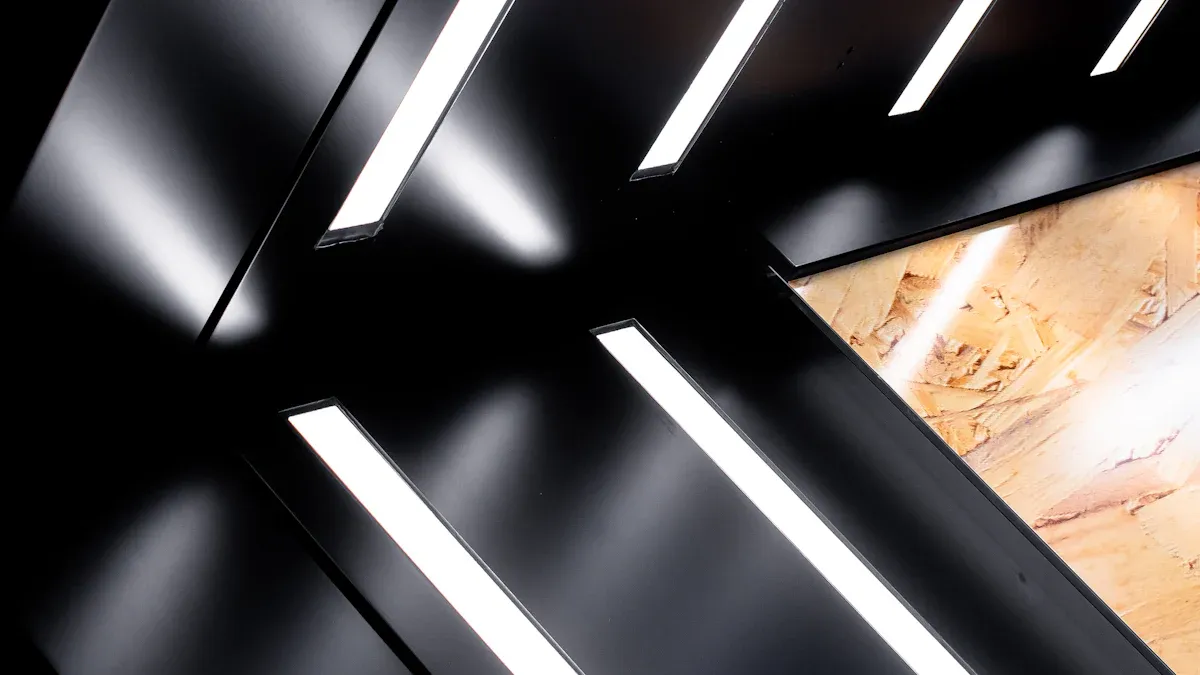
When to Choose COB LED Strips
COB LED strips are great for smooth, even lighting. They don’t show dots, making them perfect for visible areas. Use them under cabinets or along walls for a clean look. If you want a neon-like glow or soft light on shiny surfaces, COB strips are ideal. Their wide 180-degree beam spreads light evenly, which is good for tasks or decoration.
These strips work well with dimmers. They keep steady light even when dimmed. This makes them great for cosy spaces like bedrooms or living rooms. However, COB strips aren’t the brightest. They produce about 120 lumens per watt. If you care more about how the light looks than brightness, choose COB LED strips.
Tip: Pick COB LED strips for neat designs, neon effects, or soft lighting.
When to Choose SMD LED Strips
SMD LED strips are best for bright and flexible lighting. They can shine up to 200 lumens per watt, lighting big spaces like kitchens or offices. Their 110-degree beam focuses light well, making them good for accents or highlighting objects.
SMD strips offer more choices. You can pick single-colour, RGB, or adjustable white options. They are also easier to maintain and keep colours consistent over time. For hidden lights, like in coves, SMD strips such as the 2835 model give smooth light without dots.
But SMD strips don’t handle heat as well. Hot areas might shorten their life. Faulty parts can also make sections stop working. Still, they are affordable and versatile, making them a favourite for general lighting.
Note: Use SMD LED strips for bright spaces, custom designs, or budget-friendly projects.
Factors to Consider When Selecting LED Strips
Think about your project’s needs when choosing between COB and SMD strips. Decide the lighting effect you want. COB strips give smooth, dot-free light. SMD strips are brighter and offer more colour choices.
Consider where you’ll install them. COB strips are better for shiny surfaces as they avoid dots. SMD strips are good for hidden setups like cove lighting. Durability matters too. COB strips handle heat better, lasting longer in tough conditions. SMD strips are fine for most home or business uses but less strong in heat.
Budget is important. COB strips cost 20% to 40% more than SMD strips. If money is tight, SMD strips are a cheaper option with decent performance. Lastly, think about dimming. Both types can dim, but COB strips give steadier light when dimmed.
Key Takeaway: Choose LED strips based on your project’s needs, balancing light quality, cost, and energy use.
Picking between COB and SMD LED strips depends on what you need. COB strips are great for bright lighting. They give smooth light without dots and stay cool. In 2024, they make up 33% of the global market. By 2032, their value may grow from USD 2.59 billion to USD 8.4 billion. This shows they are popular for saving energy.
SMD strips are cheaper and more flexible. They are used in many places, like homes and smart systems. Their growth rate is expected to be 10% by 2034, showing they are becoming more common.
Tip: Think about what matters most—light quality, saving energy, or cost. Choose the best COB or SMD LED strips for your project.
FAQ
What is the difference between COB and SMD LED strips?
COB LED strips provide smooth, dot-free light output, while SMD LED strips offer flexibility and more colour options. COB strips excel in even lighting, whereas SMD strips are better for decorative and adjustable designs.
Which LED strip is more energy-efficient?
Both COB and SMD LED strips save energy compared to traditional lighting. COB strips handle heat better, making them slightly more efficient. SMD strips produce higher brightness output per watt, which can also reduce energy costs.
How long do COB and SMD LED strips last?
COB LED strips have a longer lifespan due to their superior heat dissipation. They can last up to 30,000 hours. SMD LED strips also offer durability but may wear out faster in hot environments.
Can I use COB LED strips for outdoor lighting?
Yes, COB LED strips work well outdoors if they have waterproofing. Their even light output makes them ideal for accent lighting on walls or pathways. Ensure proper installation to maximise their lifespan.
Are SMD LED strips suitable for task lighting?
SMD LED strips can be used for task lighting, especially in areas requiring high brightness. However, they may produce visible dots, which might not suit tasks needing smooth light output.
See Also
Understanding COB And SMD LED Strips: Key Differences And Uses
Three Main Differences Between COB And SMD LED Strips
Exploring The Benefits Of Dimmable COB LED Strips
Choosing The Ideal RGB+W COB LED Strip For Your Requirements

